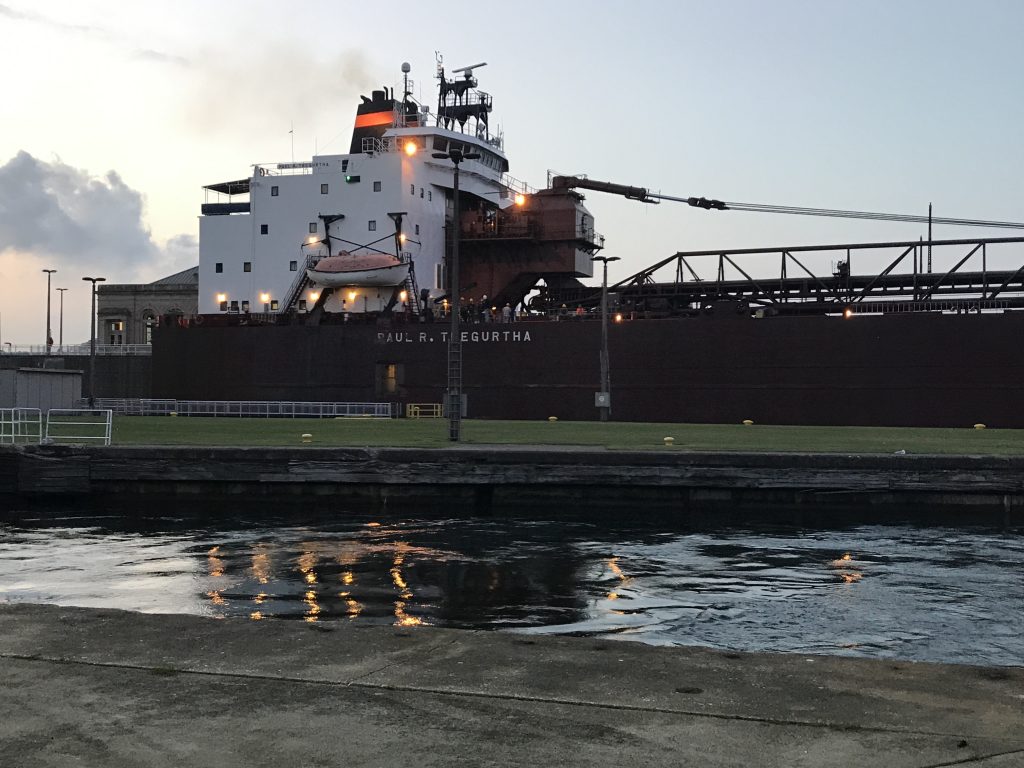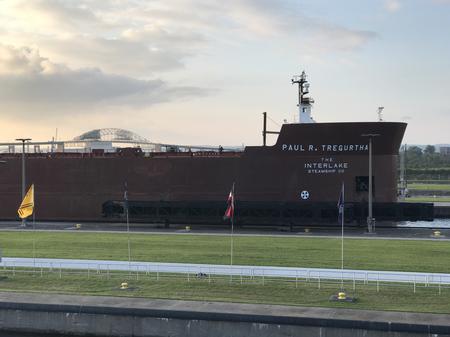The Army Would Like to Lock Up New Funds for the Soo [VIDEO]
Pres. Trump’s pledge to help the Soo Locks encourages the Corps of Engineers’ Detroit commander.

The U.S. Army Corps of Engineers has been waiting three decades to build a new shipping lock in Sault Ste. Marie, Michigan. Congress authorized the project in 1986, but has provided little funding since then. President Donald Trump gave those who support a new lock a glimmer of hope during a rally in Macomb County in April.
“Your lock, it’s not working too well, right? Not working too well. Well it hasn’t been fixed in 50 years…be nice to fix it.,” the president said.
The locks are actually in pretty good working order, according to Lt. Col. Dennis Sugrue. He commands the Army Corps of Engineers Detroit District, which manages the Soo Locks. The problem, he says, is that only one lock is large enough to handle the largest ships on the Great Lakes. And two other locks, built a century ago, haven’t been used in about 10 years because they’re too small for big freighters such as the 1,013-foot Paul R. Tregurtha.

Lt. Col. Sugrue says if the largest lock–named for Soo Locks designer Orlando Poe–were to shut down, it would restrict the flow of ore from Great Lakes iron mines to steel mills. And that would disrupt the U.S. economy.
“That’s really the critical issue here, the value chain of iron ore, steel production, and manufacturing,” Sugrue says. “And what you have now is the majority of the commodity moving between mines and mills restricted to that single lock, the Poe Lock”
Smaller ships–those shorter than 780 feet–can use the MacArthur lock, which was built in 1942. He says building a new lock is one of his top priorities. He says it would cost about $1 billion and take 7-10 years to build. Governor Rick Snyder said the state will set aside $50 million in the 2019 budget to help jump-start construction of a new lock, which would replace two smaller locks built in 1914 and 1919. The Sabin and Davis locks haven’t been used in about a decade.
Learn how and when you can actually walk out onto the locks here.
WDET’s Pat Batcheller interviewed Lt. Col. Dennis Sugrue, District Commander for the U.S. Army Corps of Engineers Detroit District. Click on the audio player to hear the conversation. Here’s a transcript:
Pat Batcheller: Are you encouraged by recent developments?
Lt. Col. Dennis Sugrue: I am. I think it demonstrates the importance and a willingness to move forward on the project?
PB: Is building a new lock on of your priorities, and if so, how great a priority?
DS: It absolutely is one of my priorities. The Soo Locks are not only critical to our district, but to the nation. You know, the ultimate goal in the Detroit district is to ensure reliable maritime navigation on the Great Lakes, and 60 percent of that moves through the Great Lakes.
PB: Can you give me a bit of history on this? When did the plan to build a new lock come to fruition, and what’s been holding it up?
DS: It was originally authorized in 1986. In 2007, Congress authorized the project to be fully federally-funded. What’s been holding it up is the commitment of funds to construction of the new lock.
PB: So Congress approved funding for it in 2007, what happened after that?
DS: There was a small amount of construction that we had in 2009, an appropriation of funds through what we called earmarks at the time. But that’s the only construction funding that we’ve received to date.
PB: And what did you work on?
DS: We deepened the downstream approach to the channels. It’s not obvious what I’m taking about there. The existing infrastructure is 23 feet in depth, but the Great Lakes navigation system operates at 27 feet in our confining channels. The other lock, the Poe, is 32 feet. And the approach channels–the channel that brings the ship into the lock–is also not at that operational depth. So we deepened the downstream part. And we installed to cofferdams, which are a necessary step in the construction. They’re temporary dams built at either end of the lock.
PB: And then the funds just sort of dried up at that point?
DS: Essentially, yes.
PB: How many locks operate now?
DS: Two. There’s the Poe Lock, which was constructed in 1968, and came into service in 1969, and the MacArthur Lock, which was built during World War II, and came into service in 1943.
PB: There are four locks on the U.S. side. What’s the status of the other two?
DS: The Sabin and the Davis are the other two locks. They were put into service in 1914 and 1919. They are both, as I described, at 23 foot depth, which is simply obsolete for the system. They’ve not been in use for about ten years.
PB: And they’re too small to handle a lot of the big freighters that come through the Great Lakes?
DS: That’s correct. The Sabin and the Davis were both 80 feet wide, as is the MacArthur Lock. The Poe Lock is 110-feet wide. So we allow ships up to 76 foot in width and 780 foot in length to use the MacArthur Lock. All ships larger than that are restricted to the Poe.
PB: And some of those ships stretch to 1,000 feet or longer.
DS: Absolutely. Lakers, or “footers”, as they’re called.
PB: How would a new lock help, and why is it needed?
DS: Essentially, the Soo Locks are a critical node in the value chain of moving iron ore to steel mills, production of steel, and manufacturing in the U.S. I think that’s well-known to officials in Michigan and the Great Lakes region at large. I think it’s become more apparent nationally. That’s really the critical issue here, the value chain of iron ore, steel production, and manufacturing. And what you have now is the majority of the commodity moving between mines and mills restricted to that single lock, the Poe Lock.
PB: And if that were to close or break down, you’d be in a jam!
DS: That’s correct. Now, it does have a good history of reliability. It’s at its design life now. Long-term reliability–having a single point of failure in any system is not something we like to get into, but that is essentially what we have at the Soo Locks now.
PB: So, what has to happen next to get this thing started?
DS: As you’re aware, we’re in the process of completing an economic validation study. We’ll complete that at the end of this month. And then, we expect the project to be in a position to compete for funds nationally.
PB: If the president and Congress can approve a specific level of funding for a new lock–if they fully fund it–how soon could construction begin, and how long would it take to complete?
DS: The consideration in the president’s 2020 budget will be the first opportunity for that. Now, we’re estimating construction to take between seven and ten years.
PB: How much would it cost?
DS: Roughly $1 billion. This is one of many national priorities in infrastructure. It’s no secret the national infrastructure needs have been outpacing our funding. The Corps is committed to investing in the nation’s water resources, and we focus on projects that have the highest returns to the nation. The study that we’re undergoing right now and the narrative that has been in the media even more so behind closed doors is informing those decisions.
PB: And this is one that you want to do because of the economic impact it would have on the entire Great Lakes region.
DS: Right. Again, not just the region, the nationally important iron ore, steel production, and manufacturing value chain.
